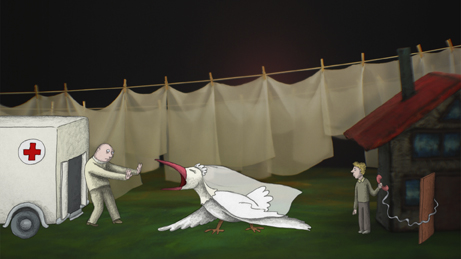![]() “Rocks In My Pockets: A funny film about depression,” Signe Baumane asserts at the end of the film’s trailer in her heavy Latvian accent. There couldn’t be a more concise statement that captures the core of her autobiographical film, which in a pitch meeting would sound disastrous. Recounting the mad and true history of five female relatives, Baumane wrote, animated, and narrated the project, blending stop-motion, hand-drawn, and papier-mâché animation. This approach to discussing schizophrenia and suicide may be unconventional, but it injects the gloomy subject matter with an irresistible dose of humor, oddity, and innocence.
“Rocks In My Pockets: A funny film about depression,” Signe Baumane asserts at the end of the film’s trailer in her heavy Latvian accent. There couldn’t be a more concise statement that captures the core of her autobiographical film, which in a pitch meeting would sound disastrous. Recounting the mad and true history of five female relatives, Baumane wrote, animated, and narrated the project, blending stop-motion, hand-drawn, and papier-mâché animation. This approach to discussing schizophrenia and suicide may be unconventional, but it injects the gloomy subject matter with an irresistible dose of humor, oddity, and innocence.
The first three minutes are a bit bewildering as the audience is met with a conflicting mixture of childlike imagery and disturbingly detailed monologues on suicide preparations, spoken with the banal tone of reading a grocery list. Baumane’s humorously exaggerated accent only adds to the viewer’s confusion: Are we meant to laugh? It is not inherently clear at first, but settling into Baumane’s twisted mindset is a lot like meeting your spouse’s eccentric uncle at a dinner party: the salad course is a little awkward, but you start to get his jokes after a few glasses of wine.
Rocks in My Pockets is a success in every sense. Baumane set out to make an adventurous, hard-to-sell film and executed it with passion, sensitivity, and humor. The visuals are beautiful yet unpretentious, combining a rich palette of colors with a two-dimensional illustration style reminiscent of children’s books. On animation, Baumane has stated on the film’s website:
“Some people mistakenly assume that animation is just for children. But animation can be a medium of very sophisticated storytelling. It is able to depict what no one can see —the utmost inner feelings and thoughts. It can deal with abstractions of problems in a way that a camera cannot… Animation can bring humor and visual metaphor to storytelling.”
Animation is also a direct gateway into Baumane’s unique perspective, one that conjures associations an average person might struggle to make. Her depictions of societal pressures, family discordance, and personal sorrow are inventive and enchanting. They unapologetically probe thoughts and fears rarely breached in “polite” conversation. Yet regardless of the weight of the topic at hand, Baumane’s statement on the film is candid and undramatic:
“I think about a wide variety of things, some fantastical, some mundane, but my mind keeps coming back to thoughts of ‘ending it all’ and the ways I could go about doing it. Why? Why do I think this way? And why I am still alive despite such thoughts? I find the fragility of our minds fascinating. Life is strange, unpredictable, sometimes absurd and I try to see the humor in it all.”
It is so common, especially in parts of Europe with a reputation for emotional repression, to dismiss such thoughts as psychotic or rare, but Baumane invites everybody to come to terms with these reflections, offering multiple perspectives and potential solutions to coping with our convoluted existence. I could write more on this film, but instead I’ll paraphrase: see this movie.








Leave A Comment